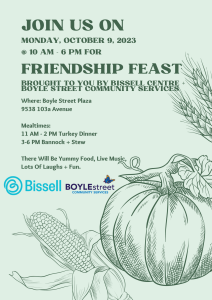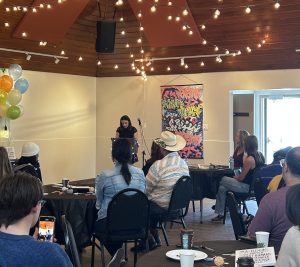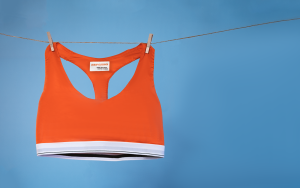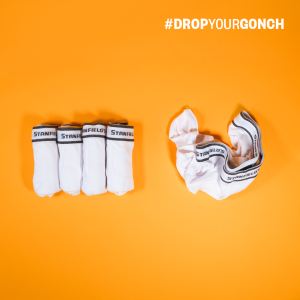We can’t say enough about our Community Space. This is the central hub where folks can come by for a hot meal, hot shower, fresh clothes, and to build relationships with people to grow their support network.
This space is invaluable to the folks who access its services every day. And, this is why our biggest fundraiser of the year, our Coldest Night of the Year walkathon, sees money raised going directly back into the operations and programs in the Community Space. For a lot of folks, this space is so much more than a warm, indoor place to meet daily necessities – it can also be the first step towards finding their unique pathways out of poverty.

Relationships are everything in the Community Space.
While things like meals and showers might be what first brings people through the doors, they soon learn what other programs might help them along. We offer programs like housing, employment, and mental health, to name a few, which help uncover what barriers people are facing. As staff work to build relationships with people to help find their strengths, folks can start recognizing how best to address these root causes.
No two experiences with houselessness are alike. Building positive relationships can help people recognize their strengths and resiliency – ultimately helping them find their path out of poverty. And, when they’re ready to take those first steps in their journey, Bissell Centre staff help find the resources they need to live a good quality of life.

Every journey is unique – and everyone gives back differently.
Doug has been coming to the Community Space for a few years now. In his own words, it’s his home away from home. The relationships he’s built are like family to him. And like any good family, he finds ways to give back.
The main way Doug gives back to the Community Space is by volunteering in the Community Closet, helping folks find new clothes. Other times, Doug walks around the encampments nearby to see if anyone needs any help. Any way that Doug can help, he wants to offer it to the community that’s given him so much.
“If it weren’t for Bissell Centre, I think we’d all be lost,” says Doug. “They’re helping me out, so I want to help them out too.”

How you can help too.
This year’s Coldest Night of the Year fundraising walk sees all proceeds raised going directly back to the Community Space to support its invaluable operations and programs. Start a team, raise some money, and bring out the whole family for a walk downtown on February 24, 2024. Thank you to all our event sponsors, including our Lead Sponsor Capital Power for providing the single largest sponsorship contribution we have ever received.
There’s an old saying that goes, “when you have more than you need, build a longer table.” Boyle Street Community Services and Bissell Centre are coming together to do just that at this year’s Friendship Feast.
This year’s Friendship Feast is on October 9, 2023, at Boyle Plaza (9538 103A Ave). Boyle Street Community Services and Bissell Centre are partnering for two meals to not only fill bellies in the community but also to celebrate the community we serve and appreciate the friendships and love that have grown.
Two Meals – Two Takes on Fall’s Favourite Feast
The first sitting will be from 11:00 a.m. to 2:00 p.m. and will be provided by Boyle Street Community Services. They will be serving up all the traditional Thanksgiving favourites like turkey, stuffing, potatoes; everything you would expect to find when family and friends get together to celebrate. Bissell will serve the second meal from 3:00 p.m. to 6:00 p.m. It will consist of Indigenous delights such as stew and Bannock from our outstanding Food Services team – a meal that’s been met with loud acclaim more than once, including recently at our National Truth and Reconciliation Day Round Dance.
A Friendship Feast Is About Coming Together
Our friends at Boyle Street Community Services recently moved out of their current location and are waiting for their new home, King Thunderbird Centre, to finish construction. We’re helping out by providing some temporary space for Boyle Street Community Service’s programs – so we can continue meeting our community members’ needs.
“This year, we’re not just filling bellies; we’re celebrating our community, appreciating the bonds we’ve forged, and sharing love through two unique meals,” says Director of Marketing and Communications Nivedita Kunjur. “It’s more than a feast; it’s a testament to friendship, unity, and the power of coming together. We’re not just serving food; we’re truly building a longer table.”

Individuals connected to our Fetal Alcohol Spectrum of Services (FASS) program contributed to a book about the challenges and realities of navigating life with Fetal Alcohol Spectrum Disorder (FASD). Under the guidance of Jared Epp, Carleton University PhD candidate and former housing support worker with Bissell Centre, who facilitated the group in sharing stories of what was most important to them. Fifteen people shared their stories, captured in this captivating collection. Born Broken is a book that’s an immersive experience into what it means to have FASD and the barriers it can create.

The group celebrated the release of this Born Broken book this past month with a small and intimate reading and sharing. Everyone who contributed to the book received a copy, and a few were shared around the community to help spread its positive message.
Copies of Born Broken books are available to purchase from the Bissell Thrift Shop on 118 Avenue or Paper Birch Books at 10825 95 Street.
Below is the preface to the book, written by Jared Epp. This firsthand experience of seeing the collection come together illuminated the importance of this book for the contributors and for those about to read it and gain a better understanding of FASD.

Preface from Born Broken
A group of individuals connected to Bissell Centre’s Fetal Alcohol Spectrum of Services (FASS) came together for a book project. The goal was to provide an opportunity for folks to share whatever kind of content they wanted. Leaving it open-ended allowed the individuals participating in the project to share what was meaningful to them. Their contributions didn’t have to only be about living with Fetal Alcohol Spectrum Disorder (FASD). A number of contributors did want to share their stories about living with FAD, about their daily challenges, as well as the impact of receiving their diagnosis. Others talked about different things. There are stories about adventure on Edmonton’s public transit, sewing denim, dreaming, making music and art, the challenges of finding and keeping a job and many other events and situations the reader will soon encounter.
Woven throughout the book are stories, ideas, frustrations, thoughts and reflections, offering a window into the experience of entering into the world a certain way.
In our last group meeting, we had to come up with a title for the book. Each contributor present was invited to come up with some titles, and then there would be a vote.
These were the title ideas:
- Born Broken
- The Struggle is Real
- Drumbeats of Hope
- Light in the Dark
- Perfectly Imperfect
- Getting Dealt a Bad Hand
Everyone had agreed on Heidi’s subtitle, “Reflections on Life and Resiliency from Individuals living with FASD,” as it put a positive spin on the main title.
Born Broken won by one vote over The Struggle is Real and Light in the Dark. There was a lot of discussion and debate on the chosen title. Some people felt it was too negative, but they also acknowledged it’s sentiment. In many ways, the titles and the debate around it set a theme that echoes through each story: individuals confronting and overcoming something they were born with, have no control over, and yet seems invisible to those outside the lived experience of FASD. The reader is invited to encounter the diverse contributions within the book, keeping in mind the unsettled nature of its title and the realities of living with FASD.
-Jared Epp

Here’s some quick math: If one person had 15,000 pairs of underwear, they could wear a new pair every day for close to 30 years.
At Bissell Centre, we give out 15,000 pairs of new underwear to our Community Members every six months – and the need is still growing.
Underwear isn’t often the first need most people think about when they want to support folks experiencing poverty. Oftentimes, clean underwear makes a huge difference not only in someone’s personal feelings and outlook. It can also help with physical and mental health issues that can be life-changing.

Physical Health Benefits of Clean Underwear
Underwear accumulates a lot of microbes from your body and collects bacteria that can fester without washing. Not only is that an awful odour to try to live in, but it also sticks to the skin and, if left for too long, can lead to infections. It’s even a direct cause of kidney failure and bladder cancer.
Changing into clean underwear is the only way to reduce that risk. If we have no underwear to give out to folks, it’s likely that many more people will be going into emergency rooms and dying from something so easily preventable.

Mental Health Benefits of Clean Underwear
A lot of difference can be made with a little more comfort. A stop by our Community Space includes a hot shower, a meal, some time to do laundry, and a stop by the Community Closet for some fresh clothes. Those four steps are crucial to folks deciding to take the next step and look for help to find their way out of poverty. When you’re working through hard times, fresh underwear is priceless.
This is where we build trust and watch their self-confidence grow. They’re not afraid to talk to people anymore. They’re okay opening up about what their goals look like. Then they start to feel dignity and understand they are worth more than their challenges or their situation. This is when they reach out for help with their mental health, addictions, housing, and employment.

15,000 Pairs of Underwear Donations are Needed
For as long as Bissell Centre has been giving clothes to folks who need them most, underwear has been the single most requested item – but it’s also the least donated. That’s why, each year, we run the Drop Your Gonch campaign. Folks don’t often think about underwear – it’s an embarrassing topic. It’s also an important topic – especially for folks in our community.
Make sure to check out the Drop Your Gonch information page for drop-off locations, donation wish lists, and lists of items we can’t accept.
And think of underwear the next time you get a bag of donations together. Pick up a fresh pair on your way and drop them in the bag. A quick extra step could change a life.

Colourful regalia. Delicious food. Traditional performances. Laughter between friends. These were just a few of the sights and sounds to behold at Bissell Centre’s celebration of National Indigenous Peoples Day on Friday, June 21, a day which also marks the summer solstice. The solstice is notable for providing the longest stretch of daylight of the year, which was fitting, as the 10 am to 1 pm celebrations saw a reprieve from the relentless stretch of rainy days. As members of our community gathered in the street together to honour the rich and diverse culture and contributions of the Canadian First Nations, Inuit and Metis peoples, the clouds parted and the sun made a welcome appearance on a day that Indigenous people have devoted to celebrating and rejoicing in our connection to the sun and the Earth for thousands of years.
But National Indigenous Peoples Day is about more than just celebration. It’s an opportunity for all Canadians to reflect on the history of mistreatment and adversity that Indigenous people have faced in Canada for hundreds of years, ever since the endless miles of Canadian soil that had belonged solely to them from the beginning of time became inhabited by groups of people who did not share their beliefs or ways of life. The Canada we know today is a beautiful cultural tapestry, brightly woven with colourful threads from cultures, ethnicities and nationalities from all over the world, and we are known internationally as a country that will welcome those who need refuge or who seek a better life for their family with open arms. Even so, it’s important to acknowledge and reflect upon the fact that Canada became the nation it is today at great cost to Indigenous people and their storied heritage. And this history is far from ancient – the last Canadian residential school did not close its doors until 1996. For many Indigenous Canadians, the scars borne of decades of intergenerational trauma and the societal inequity that First Nations, Inuit and Metis people continue to face today often makes the healing process a long and difficult one.
While National Indigenous Peoples Day is an opportunity for both celebration and reflection, it also offers the promise of community. As the sun rose to its highest point in the sky over Bissell Centre on Friday, it shone down upon traditional performances of drumming, singing, and dancing, Indigenous art forms that continue to be passed down from generation to generation as visceral representations of the beauty, passion and deep spirituality of Indigenous culture. It alighted down upon friends, families and loved ones of all different cultures sitting down to a delicious traditional meal of stew and bannock, sharing stories and laughter as they ate together. It cast its dazzling light upon a day meant not only to celebrate the countless contributions that First Nations, Inuit and Metis peoples have made to Canada, but also for us as a wider community to show our solidarity with our Indigenous brothers and sisters and the adversity they continue to encounter every day.
Bissell Centre, founded in 1910, has always been an ally to the Indigenous community. In the days when Indigenous religious ceremonies and cultural practices were illegal in Canada, Bissell Centre provided a safe haven for Indigenous leaders to practice and keep their rich culture alive. We continue to strive today to be an organization where Indigenous traditions and practices are not merely accepted, but celebrated – not only on National Indigenous Peoples Day, but every day of the year.

” On the streets, a shopping cart is called a “buggy.” When I was homeless, I avoided “pushing a buggy” as long as I could. When that day finally came – when I had to get something from point A to Point B and had no other option but to use a shopping cart – I could no longer be in denial about my situation. I was homeless. As you can imagine, accepting that reality was devastating. That day was really a low point of my life. Maybe one of the lowest. I wish I could put into words how crushing it was to my sense of worth. Accepting that I was homeless meant that I had to also accept I may never get out of homelessness. But I was one of the lucky ones.”
Taken from “Invisible People,” a blog by the homeless about being homeless. Click here to read more.
The photograph above made me think. How often I am annoyed when I have a grocery cart with a wobbly wheel or that puts out an irritating squeak while I fill it up with food and supplies. The photograph reminded me of how crazy that is — to be so blessed that I can fill a grocery cart but instead of being grateful I am whining about a very small inconvenience.
A short while ago I wrote a blog posting here called “Move the Homeless Along?” in which I shared with you the pressures we are facing at Bissell Centre to actively discourage homeless people from congregating around our facilities. As mentioned in that narrative, I shared that there are voices telling me that it is better to scatter the homeless around the city than have them grouped together. I also shared my view that the rising pressure we are facing to move the homeless along is motivated by a desire for a better, cleaner, less upsetting aesthetic. Simply put, homelessness is ugly and upsetting and people don’t like to look at it or put up with its many side effects like drunkenness, human waste, needles scattered across lawns and in back alleys, and the eyesore of unkempt people.
I am troubled by all of that, too. We have staff make rounds several times a day picking up needles, cleaning up waste, and trying to stop open drug and alcohol use. We also had a crew going around the neighborhood recently cleaning up debris and litter as well as the paraphernalia of homelessness. I have no delusions about making a huge improvement doing that, but it’s better than doing nothing.

Now we are facing pressure to participate in actions that will take away grocery carts from the homeless. Yes, I know those carts were stolen from grocery and department stores and I know it is a crime to steal such carts. If the theft of grocery carts is a high priority for the police, I will understand if they take actions to reclaim them; the police have a mandate to stop crimes and arrest people breaking the law. Arresting people for grocery cart theft won’t end the use of carts by homeless people, however.
Grocery carts or “buggies” represent the last efforts of homeless people to have the ability to keep what little belongings they have: their blankets and tarps,extra clothing, bottles and cans, and so on. People pushing buggies and carts are doing so because, without them, they have nothing. Our mandate is to help the homeless. We help them by housing them, linking them to needed health services, assisting them with addictions issues, and we also feed and clothe them. There are very few organizations that welcome the homeless into their facilities daily and actively care about them and for them.
That’s why our drop-in centre is staying open this winter seven days per week from 6 a.m. until 9 p.m. and why we have outreach staff on the streets 24 hours per day, 365 days per year. We are able to do this with the support of organizations like Homeward Trust and REACH Edmonton, among other funders, but also because of individual donations from citizens across the city who actually want us to do as much as we can to help the homeless and the poor with housing, support, and the wide variety of interventions we are able to provide.
Ending homelessness will not be served by scattering the homeless across the city. It will not be served by stripping the homeless of their carts; in fact, doing so will do nothing but harm the general community’s interest in stopping homelessness from occurring in the first place. It may improve aesthetics and it may give some of us the impression that homelessness is not such a huge problem, but the truth is that if we want a community free of people pushing grocery carts, we need to end the homelessness of those currently experiencing it while preventing others from ending up on the street.
If anything, feel free to pressure Bissell Centre to do more of that work to end poverty and homelessness. Share that pressure with our provincial and civic leaders, the lead staff of funders and faith groups, and our corporate leaders as well. Yes, all of those mentioned are trying to end poverty and homelessness, but we have a long ways to go. We feel that pressure every day at Bissell Centre when we have to tell a homeless person there is no place we can find for them – and we are pretty good at finding accommodations as are other organizations focused on finding homes for the homeless.
There are a number of definitions for the word, “crime.” One of them is about doing something against the law and stealing a grocery cart fits that definition. In this instance, the homeless would be seen criminals and could be arrested. But there are other definitions of crime such as “a grave offense especially against morality” and “something reprehensible, foolish, or disgraceful” (Merriam Webster). In this case I suggest that homelessness is the crime. That said, I am not sure who should be arrested for that.
Bissell Centre will continue to work hard to eliminate the need for carts by participating in the collective efforts of those committed to ending homelessness.
If you are interested and able to help us with our work to do more, please consider investing in Bissell Centre by donating to our mandate to eliminate poverty and end homelessness.
Mark Holmgren, CEO
The other day I was talking with two of my staff about the increasing efforts we are seeing across the city to “move the homeless along.” Some who advocate for dispersing the homeless tell us it is better to scatter the homeless across the city than to allow them to congregate around places like Bissell Centre or to camp out in groups in the river valley or other “hidden” places. I am not really sure how it’s “better” but it appears the sentiment is shared by more than a few.

I do realize that the aesthetics of homelessness are unpleasant and can make those who have a home to go to each night uncomfortable, if not distressed by what often accompanies homelessness: drug use, public drinking, needles on the ground, and human waste in the back lanes. I get it. I don’t like it either. It is unsettling.
But moving the homeless along does nothing but make the reality of being homeless less visible, and perhaps for some the illusion that things are getting better. I don’t think it improves public safety or the safety of the homeless, and I am sure scattering the homeless does not solve the community’s problem of homelessness.
Being homeless is degrading and painful. Not having a place to call home hurts. It is humiliating to have nowhere to go to the bathroom. Drugs and alcohol are both among the many the activities that lead to homelessness and the means by which people escape the despair of having no home.
Solutions are not easy. Despite the hundreds of chronically homeless people we successfully house each year, we see more and more homeless people walking through our doors. Lately, we are seeing more families. The other night a family slept outside by Bissell Centre. One of them was a two-year old. Where should we move them along to? Read More…
On Wednesday, August 14th, CTV News reported of an incident involving the police confiscating the belongings of homeless individuals near Bissell Centre on Tuesday, August 13th. Our position on this matter is that the news report fails to address the complex issues facing homeless people, the community, as well as the Edmonton Police Service and social agencies like Bissell Centre.
Homeless individuals come to Bissell Centre for a variety of services, but also they come to our agency because they feel safe and welcome. Our organization faces regular and growing pressure from the surrounding community, city officials, and the Edmonton Police to control and manage the growing numbers of people who congregate, with their shopping carts, around Bissell Centre as well as the many individuals who camp out on and around our property.
We understand that residents in the area have concerns about their safety. Community safety is actually one of the reasons we allow homeless people a sanctuary within Bissell Centre and on our property. Moving them along does not solve their problem and simply displacing the homeless to other areas in the neighbourhood is not an answer either.
Others may find the homeless to be an unsightly visual and incongruent with the development going on in the area. The real problem at hand is far more complex than shopping carts and campers – people are homeless. Bissell Centre is not worried about shopping carts and does not condone actions to “move the homeless along” in order to address what others believe is an unsightly aesthetic. Addressing homelessness by scattering the homeless around the community solves nothing and we suggest does not do anything to increase community safety.
We are concerned, as are the police and the local community about drug trafficking and usage, local crime, including violent crime, and community safety. However, we believe that the solution is more funds to house people as well as more programs that address mental health and addictions issues, rather than taking their shopping carts and disposing of their items.
Bissell Centre is working with the Edmonton Police Service and other service providers in a number of ways to increase our collective capacity to help the homeless get off the street. When we face a serious incident at Bissell Centre, the police are quick to respond and take appropriate action.
We have asked the police to help us increase the safety of our clients and the community, however we would not phone and ask them to confiscate shopping carts along with people’s belongings. We have also acknowledged that the police have a job to do and we understand that at times the actions they take will include making arrests for criminal activity as well as undertaking actions that they believe are critical to addressing crowd control and community safety.
I have instructed my staff to help those individuals who had their belongings confiscated by issuing them clothing and other items and services we have that can assist them.
Mark Holmgren, CEO
Bissell Centre
At Bissell Centre, we want to ensure that we’re doing all that we can to enhance the quality of life for all who live, work and frequent the McCauley Area, where we’ve been based since 1910.
Part of our commitment is playing a role in helping to revitalize our community, making it a cleaner and more accommodating place for everyone.

We pay attention to what happens in our community and our city in order to be the best neighbours that we can. The McCauley Revitalization Strategy, which took shape a couple of years ago, has allowed us to continually focus on our role in improving our community. Cleanliness was a key concern identified by all parties who helped in the formation of the strategy.
For us, this provided an amazing opportunity…
With grant funding becoming available through the City of Edmonton, we’re proud to say that we were successful in recruiting a Clean Streets Coordinator! The Clean Streets Coordinator will be able to hire teams of people who are registered in our Casual Labour Program. It will assist us to work with businesses, individuals and other agencies in the community to make our streets and public spaces cleaner and safer.
Helping to revitalize the community, support those looking for work, enhancing our role in developing our community and working to eliminating poverty by empowering people…its part of what we do!
I wrote this little story – a blend of fiction and non-fiction – some years ago and just rediscovered it in my personal archives (which is a nice way of saying, among the stacks of papers kept in many boxes). It was written in the summer-time, but for me, it is a Christmas story about hope and change. I hope you like it.
***
ERNIE
Like you, I am frequently approached for a hand-out by someone on the street. Sometimes I hand over some change. Sometimes I don’t. When I don’t is when I find myself rationalizing that I don’t want to support someone’s drinking habit. Giving them a sandwich would be more appropriate, I tell myself. But of course, I don’t carry a sandwich in my pocket and I don’t go buy them one. I just walk away with my self-sustaining rationale.
I bet most of us do that more often than not. Yes, I know. Handing over a dollar won’t solve anything. What difference will I make? Maybe I will cause more harm than good. Who knows? Then I remember a fellow I knew years ago. His name was Ernie. He had been on the streets for twenty years – a heavy drinker, the personification of a “bum.” The kind of man you walk around if you see him coming down the street. All of my colleagues figured he would die on the streets.
Ernie comes to mind for a couple reasons. First, because he was always willing to share what he had – which wasn’t much – with anyone who asked. He was just that way, an all around nice guy (despite his rough appearance), even when drunk on Lysol or cheap wine. Second, one day Ernie just quit drinking and never started again — at least for as long as I kept track of him anyway, which was for several years.
One day I asked why he just stopped drinking.
He gave me a big smile and shook his head. “I don’t really know,” he said. “I just woke up one morning and said that’s it. I’m done. I threw out what little booze I had in my room, took the empties to the depot and headed to the Gold Nugget for breakfast.”
I guess I was looking for more of a watershed moment from Ernie, some kind of spiritual turning point – anything other than “I don’t really know.”
“Something troubling you, son?”
I shook my head. “I just thought you would know the reason.”
Ernie laughed. “I can think of some now, looking back. Like I didn’t want to die yet. But at the time, the honest truth is I didn’t know. I just quit.” He paused for a moment. Ernie had always been a thoughtful man and had an uncanny sense of other people. “You,” he said. “You were good to me – and the others at the drop-in, you know, the workers there.”
“Thanks,” I said. “I wasn’t fishing though…”
“Maybe you were, maybe you weren’t,” Ernie said. “But it’s true anyways. It wasn’t that you were social workers. You were just people, decent you know. You gave me change, bummed me smokes, gave me rides when my arthritis was bad. You just hung out and talked. I never got the feeling you were trying to save me. I hated that – people trying to save me.”
I didn’t know quite what to say, so I shifted gears. “So did you enjoy your breakfast that first day – you know, at the Gold Nugget.”
“Nope,” Ernie said. “I got sick like a dog, and then I gave all my change to Stanley – you know him, right?”
I nodded.
“He was in a bad way and needed a fix more than I needed my little bit of cash.”
“I understand,” I said.
Ernie looked at me. He smiled a little. “I imagine you do, son. I imagine you do.”
I don’t know where Ernie is today, but I have a feeling he is alive and sober. He’s still poor no doubt and living day to day on his disability checks. He’s probably still off the streets living in a small room in McCauley or somewhere along 118th Avenue.
But one thing I know for sure. When Ernie comes across an outstretched hand, he stops and gives them what he can. Knowing him, he likely has a chat as well. And when he finally does move along, he’s not wondering if he should have bought them a sandwich. Maybe he understands these things better than we do because he was there and then one day things just changed. I figure that if that can happen to an old alcoholic bum named Ernie, maybe it can happen to other folks, too, even folks like you and me.
The very last time I saw Ernie was a couple years after I left my job in the inner city. I was walking along Whyte Avenue on my way to Greenwoods to buy a book. He was headed the other way, moving slowly with his wooden cane.
“Hey, Ernie,” I said. “Long time.”
Ernie looked up at me and smiled. It took him a moment to recognize me. “Mark,” he said. “How’s things?”
“Good,” I said. “Real good. You?”
“Same as usual. My leg hurts a bit more lately than usual, but can’t complain really.”
We stood there for a few minutes, talking about other folks we knew, those who had died, others who had left town, the few who were still walking 96th Street each day. People streamed by us, oblivious to our reunion, except for a young man in a business suit who gave us a dirty look for being in his way.
Ernie smiled at the man. “To have old friends, son, you got to make a few first.”
I laughed. The young man didn’t, but he went away.
And then it was time. “Mark,” Ernie said. “I should be getting on.”
We said our goodbyes and then continued on our separate ways. A few steps later, I turned around. “Ernie,” I yelled.
Ernie turned half way toward me
“Good to see you,” I said.
Ernie nodded and gave me a little wave with his cane and then shuffled off through the crowd.
As I waved back I caught my reflection in the shop window. I stepped forward to get a better look but then thought better of it. I didn’t want to frighten people in the store gawking like some stalker! So I crossed the street and walked into the bookstore. I felt different somehow, but wasn’t sure why. All I know is I felt somehow changed by an old man with a bum leg who had quit drinking years ago for reasons he didn’t understand at the time.
Like most people, I wish for a lot of things in my life. I hope my children will be happy. I hope my wife loves me as much as I love her. I would like more money, who wouldn’t? I hope for less violence and pain in the world.
I also wish I could be more like Ernie. And on that day in the middle of summer, I wished for that more than anything.















